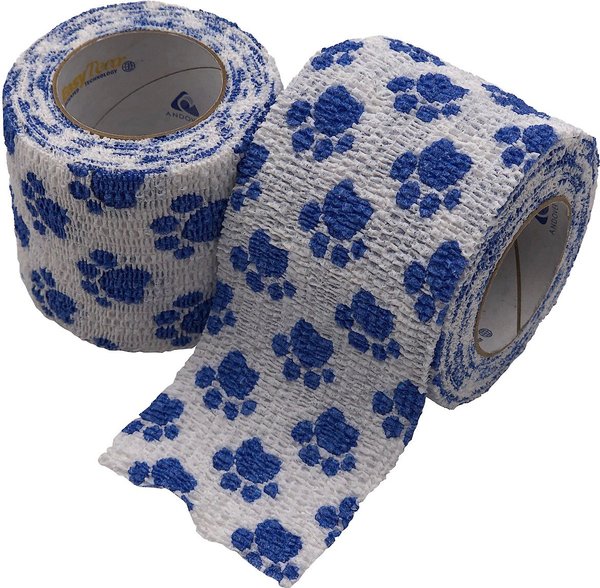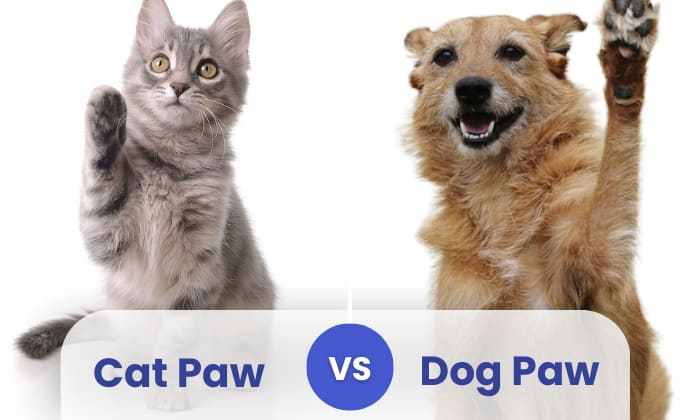Dog paw prints have a more oval shape compared to the rounder shape of cat paw prints. Dog paw prints also have claw marks present while cat paw prints typically do not. Paw prints can be a useful indication of what kind of animal is present in a certain area, and can also offer insights into the animal’s behaviors and movements. Dog paw prints and cat paw prints, in particular, can be distinguished from one another through their shape and the presence of claw marks.
Dog paw prints tend to be more oval-shaped with claw marks present, while cat paw prints are typically rounder and lack claw marks. Additionally, analyzing the size and pattern of the paw prints can also provide further information about the animal’s size and gait. Understanding how to identify different paw prints can help with animal tracking, pet identification, and even wildlife research.

Credit: www.chewy.com
Anatomical Differences
Dog Paw Print Vs Cat Paw Print – Anatomical Differences
A detailed understanding of the structural differences between a dog paw print and a cat paw print can be fascinating. Both animals, despite being close companions, exhibit distinct differences in their paw anatomy. We will examine the intricate details of dog and cat paw prints to explore their fundamental anatomical variations.
Describe The Structure Of Dog Paws In Detail
A dog’s paw print usually outlines several visible elements that work together to create the print’s overall structure. Below are some of the core components that contribute to the unique appearance of a dog paw:
- The pads: A typical dog paw has five pads, including the central pad (large triangular pad) and four other smaller pads, including two digital pads and two metacarpal pads.
- Claws: Dogs possess claws that help them grip surfaces, as well as provide them with defensive weapons. The claws’ length varies for different breeds, depending on their lifestyle.
- Dewclaws: Some dogs have additional bone structures that are not used as frequently as their claws (referred to as dewclaws). These structures don’t usually touch the ground but can be observed on the animal’s paw print.
Compare And Contrast The Structure Of Cat Paws
One can easily distinguish a cat paw print from a dog paw print since they exhibit several variances in the number of toes and the structure of their pads. Here’s how cat paw prints differ from dog paw prints:
- Toes: A cat’s paw print comprises five toes, but only four toes leave imprints. The fifth toe, also known as the dewclaw, is higher up on the paw and does not come into contact with the ground.
- Pads: The pads on a cat’s paw are much softer and more cushioned than the pads on a dog’s paw. The two main pads observed on a cat’s paw are referred to as the metacarpal pad and the digital pad. These pads also have a unique ‘m’ shape, which is a distinctive identifying feature.
- Claws: Unlike dogs, cats retract their claws to keep them sharp and avoid blunting them when walking around. Therefore, cat paw prints typically don’t feature visible claw imprints.
A deep understanding of the anatomical differences between dog paw prints and cat paw prints will undoubtedly provide an insightful perspective on the distinct characteristics of two of our most beloved animal companions.
Environmental Adaptation
Dog Paw Print Vs Cat Paw Print: Environmental Adaptation
Pets are a delightful addition to households. However, different pets have distinct physical features and adaptations that play a key role in their survival in various environments. One of the most distinctive aspects of pets is their paw prints. In this section, we will explore how dog and cat paw prints adapt to different environmental conditions.
Explaining Dog Paw Prints
- Dog paw prints have unique adaptations that assist them in various environments.
- The paw’s size, shape, and texture are all critical features that assist dogs in adapting to diverse terrain.
- Dog paws have thick pads that provide them strength and flexibility on rocky terrains.
- The webbing between their paw pads helps in walking on marshy terrains.
- Their claws are designed to dig into the ground when they need to grip while walking on slippery surfaces.
Explaining Cat Paw Prints
- Cat paw prints have distinct physical features that allow them to adapt to a variety of environments.
- Their paws have retractable claws that assist in maintaining balance and stability on unstable surfaces.
- The paw pads are equipped with sweat glands that keep them moist while walking on hot surfaces.
- The fur in between the pads helps to trap heat during cold weather as well as provide insulation on the snow.
The paw prints of dogs and cats are uniquely adapted to assist them in various environments. By understanding their paw prints’ physical features, pet owners can take good care of their pets in different surroundings and keep them comfortable.
Paw Print Identification
Dog Paw Print Vs Cat Paw Print
As every pet owner knows, paw prints can be an adorable reminder of their furry friend’s presence. But did you know that paw prints can also play a crucial role in forensic investigation? Despite similarities, dog, and cat paw prints differ significantly from each other.
This article discusses the role of paw prints in forensic identification, the differences between dog and cat paw prints, and the usefulness and limitations of paw print identification in criminal investigations.
Discuss The Role Of Paw Prints In Forensic Identification.
Forensic identification is an important aspect of criminal investigations. It involves analyzing various pieces of evidence, including fingerprints, DNA samples, shoe impressions, and other marks left at the scene of the crime. Paw prints can also serve as valuable evidence in such investigations. They are particularly useful in cases where the suspect is an animal owner or where animal-related offenses have occurred.
Describe How Dog And Cat Paw Prints Differ From Each Other.
Dog and cat paw prints differ in many ways. Here are some key differences:
Plain paragraph:
- Dog paw prints are generally larger than cat paw prints.
- Dog paw prints have claw marks that appear separate from the rest of the print, whereas cat paw prints do not show any claw marks.
- Dog paw prints have a more prominent central pad with two lobes, whereas cat paw prints have a central pad with three lobes.
- Dog paw prints are rounder and wider than cat paw prints, which are more elongated and narrow.
Usefulness And Limitations Of Paw Print Identification In Criminal Investigations
While paw prints can be valuable evidence, there are certain limitations to their use in criminal investigations:
Bullet points:
- The accuracy of paw print identification can be affected by environmental factors such as weather conditions, surface type, and time elapsed since the prints were made.
- Paw prints cannot provide definitive identification of the animal responsible for the print or the handler of the animal.
- Paw prints cannot provide information on the timeline of events or whether the animal was intentionally used in criminal activity.
- Paw print analysis requires specialized training, equipment, and resources, which may not be readily available in all cases.
Paw prints can be a valuable piece of evidence in forensic investigations, particularly in animal-related offenses. Dog and cat paw prints differ in many ways, and analyzing these differences can help identify the animal responsible for the print. However, the usefulness of paw prints is limited by environmental factors, interpretation difficulties, and specialized training requirements. Despite these limitations, paw prints remain an important tool for investigators in animal-related cases.
FAQ For Dog Paw Print Vs Cat Paw Print
What Is The Difference In A Dog Paw Print Vs Cat Paw Print?
The main difference between dog paw prints and cat paw prints is that dog paw prints are generally larger due to their larger body size. Additionally, dog prints tend to have a more muddled appearance, while cat prints have a more distinct look with visible claws.
Can You Tell The Size Of The Animal From Its Paw Print?
Yes, the size of an animal’s paw print can give you a rough idea of its size. The larger the print, the larger the animal. However, keep in mind that there can be variations within a specific species such as large vs.
small dog breeds.
Are Dog And Cat Paw Prints Unique To Each Animal Like Fingerprints For Humans?
While dog and cat paw prints can vary depending on the specific animal, they are not unique in the same way fingerprints are for humans. However, like fingerprints, there can be slight variations in each animal’s paw print.
Can You Identify If A Paw Print Belongs To A Dog Or A Cat?
Yes, you can typically identify if a paw print belongs to a dog or a cat based on the shape. Dog paw prints are usually rounder with four toes at the front, while cat paw prints are more oval-shaped and have five toes at the front with visible claw marks.
How Can You Tell If A Paw Print Is Fresh Or Not?
To tell if a paw print is fresh, check for signs of distortion or erosion around the print. If the print looks crisp and has well-defined edges, it’s likely to be fresh. Additionally, if the ground is soft and the print looks deep, it’s more likely to be a fresh print.
Conclusion
It’s intriguing to note the differences between dog and cat paw prints and how they relate to their behaviors and habitats. A dog’s paw print is more prominent, and the claws usually leave a mark as well, while a cat’s paw print is subtler and more compact.
Dog paw prints are typically seen on open grounds, while cat paw prints are commonly found on soft surfaces like soil or sand. The variation in paw print sizes and shapes can also be used to identify different breeds within each species.
As pet owners, observing and understanding the unique characteristics of our pets’ paw prints can help us better understand their behaviors and enrich our bond with them. It’s fascinating how much information can be extracted from such a seemingly insignificant detail.
As we continue to study and appreciate the natural world around us, let’s not forget to observe, appreciate, and cherish our furry companions and their paw prints.



